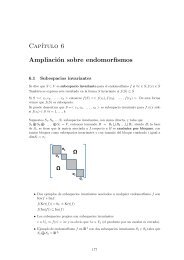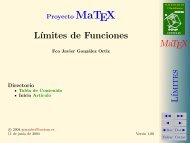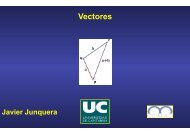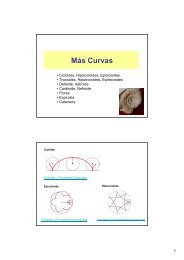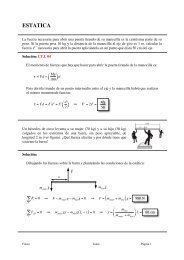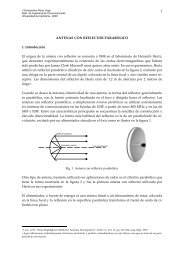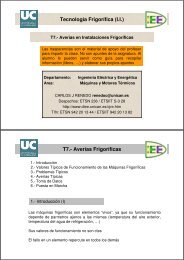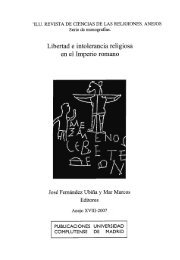Estimators based in adaptively trimming cells in the mixture model
Estimators based in adaptively trimming cells in the mixture model
Estimators based in adaptively trimming cells in the mixture model
You also want an ePaper? Increase the reach of your titles
YUMPU automatically turns print PDFs into web optimized ePapers that Google loves.
But this property is only possible if <strong>the</strong> subsequence {j n } n satisfies (22).<br />
Now, let us suppose that 2 or 3 hold. Let {j ′ n} n be a subsequence of {j n } n . Obviously, <strong>the</strong>re exists a<br />
subsequence {j ∗ n} n of {j ′ n} n which satisfies that for every i ∈ {1, ..., k},<br />
lim <strong>in</strong>f λ j∗ n<br />
n i > 0 and lim ‖ψ j∗ n<br />
n<br />
i ‖ = ∞ or lim ψ j∗ n<br />
n<br />
i = ψ i ∈ Φ,<br />
and <strong>the</strong>re also exists i 0 such that lim n ‖ψ j∗ n<br />
i0<br />
‖ = ∞, or lim n δ j∗ n<br />
i0<br />
= 0. Without loss of generality we can<br />
assume that i 0 = 1. As before, we will denote jn ∗ = n, for n ∈ IN. Let<br />
D n := { x ∈ A γn : IP θ ∗<br />
n<br />
[1/x] > u/2 } .<br />
Then IP n [D n /A γn ] > u/2, and argu<strong>in</strong>g as <strong>in</strong> (20) and (21), we have that u(1−α)/2 ≤ lim <strong>in</strong>f n IP n (D n )<br />
and, if x ∈ D n , that<br />
f θ ∗<br />
n<br />
(x) ≤ k2δ n 1 g ψ n<br />
1<br />
(x)/u. (23)<br />
On <strong>the</strong> o<strong>the</strong>r hand, <strong>in</strong> this case, we have that K 2 := sup n sup i M(ψi n ) < ∞. From here and (23) we<br />
have that<br />
]<br />
IP n L θ ∗<br />
n /γ n<br />
≤ IP n<br />
[I Aγn ∩Dn c log f [ ]<br />
θn<br />
∗ + IP n IDn log f θ ∗<br />
n<br />
≤ log + (K 2 ) + log (k2/u) + IP n<br />
[<br />
IDn log(δ n 1 g ψ n<br />
1<br />
) ] ,<br />
which converges to −∞ for <strong>the</strong> subsequence we are consider<strong>in</strong>g, and <strong>the</strong> proof ends as <strong>in</strong> <strong>the</strong> previous<br />
case.<br />
•<br />
Lemma 6.3 If IP is absolutely cont<strong>in</strong>uous and <strong>the</strong>re exists δ > 0 such that θ P<br />
exists N 0 ∈ IN such that if n ≥ N 0 , <strong>the</strong>n θ P ∈ Θ n γ n ,u.<br />
∈ Θ γP ,u+δ, <strong>the</strong>n <strong>the</strong>re<br />
PROOF.- From <strong>the</strong> cont<strong>in</strong>uity of <strong>the</strong> map x :→ IP θP (i/x) and 2 <strong>in</strong> Proposition 6.2, we have that<br />
IP θP (i/Y n )I Aγn (Y n ) →a.s. IP θP (i/Y 0 )I AγP (Y 0 ). (24)<br />
Now, tak<strong>in</strong>g <strong>in</strong>to account that IP θP (i/·) ∈ [0, 1], we obta<strong>in</strong> that<br />
[<br />
] [<br />
]<br />
IP n IP θP (i/·)I Aγn = ν IP θP (i/Y n )I Aγn (Y n )<br />
[<br />
]<br />
→ ν IP θP (i/Y 0 )I AγP (Y 0 )<br />
]<br />
= IP<br />
[IP θP (i/·)I AγP ≥ (u + δ)IP<br />
[A γP<br />
]<br />
,<br />
and <strong>the</strong> proof ends by apply<strong>in</strong>g 3 <strong>in</strong> Proposition 6.2.<br />
•<br />
Corollary 6.4 follows from Lemma 6.3 and 5 <strong>in</strong> Proposition 6.2, tak<strong>in</strong>g <strong>in</strong>to account that <strong>in</strong> Proposition<br />
4.4 we can take <strong>the</strong> vectors θ ∗ n as close as desired to <strong>the</strong> optimum parameters.<br />
Corollary 6.4 If IP is absolutely cont<strong>in</strong>uous and <strong>the</strong>re exists δ > 0 such that θ P ∈ Θ γP ,u+δ, <strong>the</strong>n, from<br />
an <strong>in</strong>dex onward, <strong>the</strong> sequence {ˆθ n } n belongs to a compact set conta<strong>in</strong>ed <strong>in</strong> Θ.<br />
26




